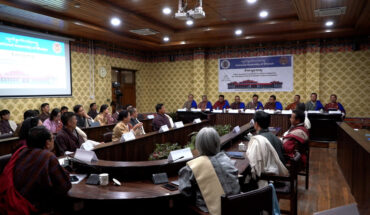
PEMA TSHOMO
Thimphu
The 7.1 magnitude earthquake that struck the Shigatse region of Tibet on January 7, 2025, reverberated far beyond its epicenter, reigniting fears of potential glacial lake outburst floods (GLOFs).
While no immediate damage was reported with this cause. The earthquake has intensified scientific scrutiny of Himalayan’s glacial lakes, particularly in the Lunana region, where seismic activity poses a persistent threat to fragile moraine dams.
The National Centre for Hydrology and Meteorology (NCHM), in collaboration with the Department of Geology and Mines (DGM), swiftly convened a technical press briefing following the earthquake to address public concerns.
Highlighting the potential dangers, the experts underlined the vulnerability of Lunana’s glacial lakes to seismic disruptions. The discussion was further amplified by recent observations of avalanches on the Bechung Glacier in Tibet, underscoring the proximity of such hazards to Bhutan.
Karma, the Cryosphere Services Division (CSD) specialist at NCHM, described the dynamics of the quake’s aftermath. “Glacial lakes like Thorthormi and Rapstreng sit in precarious positions that poses a unique threat. So, a significant avalanche or wave impact could destabilize the moraine walls, leading to catastrophic flooding downstream as a GLOFs,” he said.
Fortunately, the avalanches triggered by the Shigatse earthquake were absorbed by the gentle slope of Bechung Glacier, avoiding a disaster. “This time, nature worked in our favor, but we cannot rely on luck,” said Karma.
The earthquake’s tremors, which registered an intensity of four on the Modified Mercalli Intensity (MMI) scale in the high-altitude areas in Gasa district, raised alarms among scientists monitoring seismic risks. Although moderate in intensity, such tremors are a reminder of the region’s geological volatility.
Karma confirmed that on-site assessments of Lunana’s major lakes showed no visible cracks or major structural instability. “There are minor moraine slides as per the visitor group up there, but they are not unusual or alarming at this stage,” Karma said, emphasizing ongoing vigilance.
The stakes are high. A breach of Thorthormi Lake could release an estimated 53 million cubic meters of water, causing untold destruction in downstream communities.
Villages like Thangza and Toenchoe, previously identified as high-risk zones, remain in the shadow of potential disaster. While relocation advisories were issued to residents last year, many continue to await financial aid to rebuild their lives in safer areas. The delays highlight the complex interplay between environmental risk and socioeconomic realities.
Nityam Nepal, a senior geologist at DGM pointed out that the resilience of natural materials used in moraine dams offers some reassurance.
“Natural materials like earth and rock are inherently stable, even when small cracks form. Unlike artificial materials, these natural structures can adapt to minor disturbances over time,” she explained.
However, a geologist warned against complacency, emphasizing the need for regular monitoring to preempt any major failures.
The quake also reignited conversations about the unpredictable nature of seismic events in Bhutan as it being a mountanious country.
Nityam Nepal also explained the science behind earthquake-induced risks. “Surface waves caused by seismic activity create intense ground shaking, which can destabilize moraine dams and trigger landslides or avalanches. So, the interaction of these forces makes glacial regions particularly vulnerable,” she said.
She shared that the different types of waves that cause air-wave are firstly with a primarily wave causes due to the air pressure followed by the secondary wave and the surface wave, which causes due to ground breaking. “We are fortunate this was not the case this time,” said the geologist.
While the immediate focus is on Lunana’s lakes, the broader implications of the Shigatse earthquake are hard to ignore.
The government, in coordination with NCHM and DGM, has been working to upgrade the country’s earthquake monitoring and early warning systems. Scheduled for completion by March 2025, the enhancements include automated data dissemination, real-time intensity maps, and a user-friendly platform for public reporting of seismic activity.
Currently, Bhutan relies on a network of 13 seismic monitoring stations and 223 intensity meters to detect and relay earthquake data.
Karma, the specialist stressed the importance of technological advancements in risk management. “Real-time monitoring and early warnings are critical for disaster preparedness. But technology alone is not enough. We need stronger community engagement and education to build resilience,” he said.
The sentiment was echoed by Nityam Nepal, who noted that while Bhutan’s scientific capabilities are improving, the unpredictable nature of earthquakes requires a multi-faceted approach.
Meanwhile, NCHM’s field teams stationed in Lunana continue their assessments of glacial lakes, braving harsh winter conditions to collect data and monitor potential threats.
Plans for more comprehensive field visits are in place, pending weather improvements. However, access to some critical sites, such as Luggye Lake, remains limited, adding to the complexity of the situation.
As the dust settles on the Shigatse earthquake, Bhutan faces a stark reminder of its vulnerability to natural disasters particularly for the Lunana people and the Mo Chu residentials.
The incident has catalyzed urgent discussions about the need for improved disaster preparedness, from strengthening early warning systems to ensuring timely relocation support for at-risk communities.
For now, the calm in Lunana offers temporary relief, but experts warn that the next seismic event could pose a far greater challenge. “Nature has given us a chance to prepare. We must not waste it,” said Karma.





